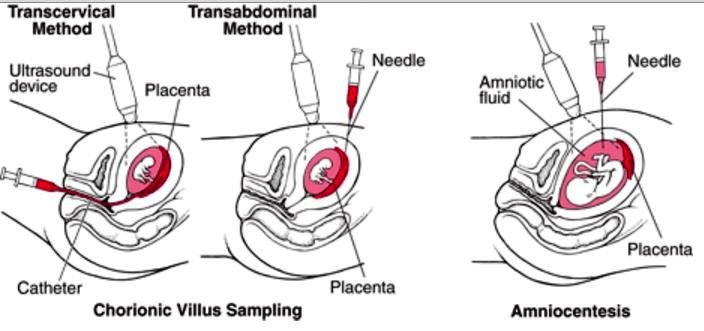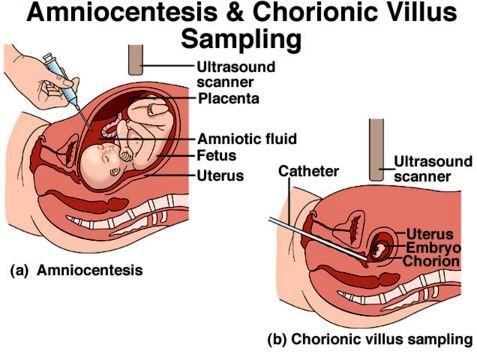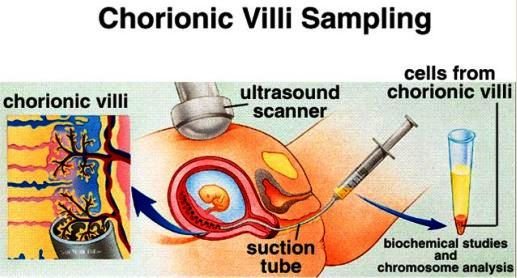Chorionic Villus Sampling
Chorionic Villus Sampling Definition
Chorionic villus sampling abbreviated as CVS is a diagnostic prenatal exam in order to assess the health status of an unborn baby for chances of developing congenital or chromosomal defects. This involves sampling of the placental tissue, specifically the chorionic villus, to assess and evaluate for some abnormalities in the chromosomes.
CVS can be done when the woman is pregnant between 10-12 weeks age of gestation, which entails that it is being performed earlier than percutaneous umbilical cord sampling or that of amniocentesis.
It is the most preferred diagnostic test before 15 weeks age of gestation, either through a transabdominal manner or in a transcervical route. CVS is linked with an assessment for Down syndrome, and other genetic problems like cystic fibrosis and Tay-Sachs disorder.
Indications
Chorionic villus sampling can provide the genetic make-up of a baby. It is highly recommended when results of the test may create an impact in terms of pregnancy management or the desire to push through with the pregnancy despite the presence of some problems.
CVS is indicated for the following factors to consider:
- Positive results or abnormal results from a prenatal screening test that is done during the first trimester or during a prenatal cell-free DNA screening procedure.
- History of a chromosomal condition with a previous pregnancy, like delivering a baby diagnosed with Down syndrome or any other chromosomal problems.
- Maternal age is 35 or older, since babies born to women aged 35 and above are known to have a greater risk of giving birth to babies with Down syndrome
- Family history of a genetic problem or in instances when a parent is a known carrier of any genetic abnormality
- Nuchal translucency is increased or when ultrasound findings are abnormal
Contraindications
Chorionic villus sampling is an invasive prenatal genetic technique that can be performed on a pregnant woman during the period of 10-12 weeks age of gestation. CVS has contraindications that guide members of the health team.
Absolute contraindications
- Pregnancy earlier than 10 weeks age of gestation
- Active bleeding is noted for the past 2 weeks
- Presence of cervical or vaginal infection such as herpes
- Diagnosis of Rhesus isoimmunization
Relative contraindications
- When the pregnancy is considered at low risk for the possibility of any genetic problem
- Multiple pregnancy of a woman
- Presence of bleeding diathesis with the patient
- When the pregnant woman is receiving heparin
- When CVS can be done through a transcervical route, such as in cases of a retroverted uterus, fundal placenta, fibroids and cervical polyps
Procedure
The procedure for CVS might generally take approximately about 90 minutes.

Image 1

Image 2

Image 3. Images 1, 2, 3 shows procedure of chorionic villus sampling
Steps for a Chorionic villus sampling:
- Patient has to be on a moderate full bladder
- Patient is dressed on a hospital gown and instructed to lie on the back on the examination table; sedative drugs might be administered on a case to case basis
- Fetal status is monitored via an ultrasound scan
- Patient’s abdomen is cleansed with an antiseptic solution using aseptic technique
- Local anesthetic is injected by the attending physician on the site
- A slender needle is inserted through the abdominal wall going into the edge of the placenta as guided by an ultrasound
- A finer needle is then threaded through the first slender needle; syringe is attached in order to create a vacuum to remove a small sample of placental tissue, taking about 2 minutes or more
- Patient may feel sensations of dragging and drawing within the pelvis and the legs which are considered normal
- Second sample might be taken as necessary
- Needles are removed once samples are successfully taken from the site for analysis
- Fetal status is checked again using the ultrasound scan
- Patient can then change and instructions are given
Results
The attending physician may inform the patient that results might not be available for a several weeks.
Normal test results:
- This means there are no signs noted for an existing genetic problem
- It must be considered, however, that CVS does not detect all abnormal conditions in the baby, like in cases of spina bifida and other neural tube defects
- Some genetic abnormalities might not be observable during the performance of chromosome studies.
Abnormal test results:
- Continuing with the pregnancy can be a major concern that has to be considered when a genetic problem or any chromosomal abnormality is being detected
- Possible genetic counseling referral might be done
Risks
The performance of chorionic villi sampling may result with the following risks:
- Cramping when it is done through the cervical route instead of the abdomen
- Amniotic fluid leakage through a cervical route
- Bleeding or vaginal spotting within 1-2 days when on a cervical route
- Soreness felt on the belly site where needle is inserted if through abdominal route
- Uterine infection might be developed since it is an invasive procedure
- Rh sensitization because of the chance that the mother’s blood might get mixed with the baby’s blood during the procedure
- Chance of having a miscarriage or an accidental abortion in about 1 in 100 cases of women who underwent CVS
- Limb abnormalities or deformities of the baby especially on the fingers and toes, although with lower chances especially if CVS is done after 10 weeks age of gestation already
References:
- http://www.mayoclinic.org/tests-procedures/chorionic-villus-sampling/basics/definition/prc-20013566
- http://www.healthline.com/health/chorionic-villus-sampling#Results6
- http://www.webmd.com/baby/chorionic-villus-sampling-cvs?page=4
Cunningham FG, et al (2014). Prenatal diagnosis. In: Williams Obstetrics. 24th ed. New York, N.Y.: The McGraw-Hill Companies. - Gabbe SG, et al (2012). Prenatal genetic diagnosis. In: Obstetrics: Normal and Problem Pregnancies. 6th ed. Philadelphia, Pa.: Saunders Elsevier.
- Pagana, K. D., & Pagana, T. J. (2011). Mosby’s Diagnostic and Laboratory Test Reference, 10th ed. St. Louis, Mo.: Elsevier Mosby.
